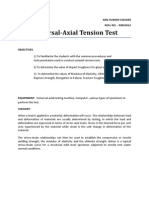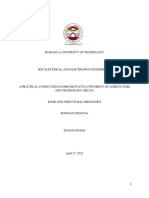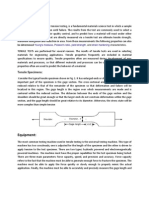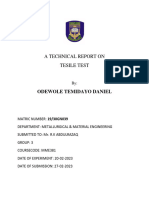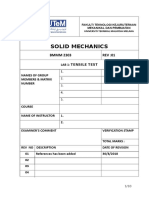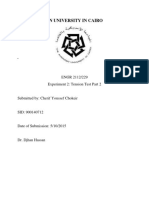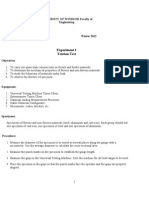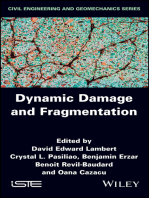pract 1
Uploaded by
mohit.toshniwal23pract 1
Uploaded by
mohit.toshniwal23Journal of Testing of Materials
Part A: Tension Test on Mild and TMT
Steel
&
Part B: Bending Test on TMT Steel
Department of Civil Engineering PCCoE, A.Y. 2021-2022 Page | 1
Journal of Testing of Materials
Experiment No: 01 Part (A)
Title : Tension Test on Mild Steel and TMT steel
Date of Performance :
Aim: To determine the tensile strength of mild steel and T.M.T. Steel.
Introduction:-
Tension test is one of the most widely used tests conducted to determine the tensile strength and
modulus of elasticity of metals. For Mild steel yield point, percentage of elongation and
percentage reduction in cross sectional area also determine by this test.
Reference:-I.S. 1608: 1995-Method for tensile testing of steel products
Theory:-
Mild steel bars are commonly used as reinforcement in concrete structures to with stand
tensile stresses; so it is necessary to test for tensile strength of mild steel bars.
Tension test is one of the most widely used tests conducted to determine strength,
ductility, toughness & modulus of elasticity of metal. In this test ends of test piece are fixed into
grips connected to a straining device and to a load measuring device. If the applied load is small
enough, the deformation of any solid body is entirely elastic. An elastically deformed solid will
return to its original form as soon as load is removed. However, if the load is too large, the
material can be deformed permanently. The initial part of the tension curve which is recoverable
immediately after unloading is termed as elastic and the rest of the curve which represents the
manner in which solid undergoes plastic deformation is termed plastic.
The stress below which the deformations essentially entirely elastic is known as the yield
strength of material. In some material the plastic deformation is denoted by a sudden drop in load
indicating both an upper and a lower yield point. However, some materials do not exhibit a sharp
yield point. During plastic deformation, at larger extensions strain hardening cannot compensate
for the decrease in section and thus the load passes through a maximum and then begins to
decrease.
specimen to original cross-sectional area, reaches a maximum value. Further loading will
eventually cause
Department of Civil Engineering PCCoE, A.Y. 2021-2022 Page | 2
Journal of Testing of Materials
1. Ductility: It is the property by virtue of which a metal can be rolled into different shapes. Due to
ductile behavior of steel it shows sufficient deflection and gives warning of failure before it fails.
2. Elasticity: It is the property by virtue of which a material returns to its original dimensions after
the removal of the stress or load. The stress strain diagram shows the performance of the tested
material by graphically expressing the stress exerted in specimen as a function of strain developed
by pulling action of testing machine from the start of pulling to the occurrence of fracture.
3. Yield stress (strength): The point at which the stress remains constant with increase in strain.
Yield strength is the lowest stress that gives permanent deformation in a material. In some
materials, like aluminum alloys, the point of yielding is hard to define, thus it is usually given as the
stress required causing 0.2% plastic strain. This is called a 0.2% proof stress.
4. Yield point: Yield point is a point on the stress-strain curve, after which there is a significant
increase in strain with little or no increase in stress. The corresponding stress is called the Yield
strength of that material.
5. Ultimate Tensile stress (strength): Tensile strength or ultimate tensile stress is the maximum
stress the material has attained. At this point reduction in cross sectional area takes place in the
specimen. It leads to reduction in the load carrying capacity.
6. Breaking stress: The stress at which the specimen breaks down. Tensile failure in the manner of
ductile failure (yield as the first stage of failure, some hardening in the second stage and break
more pieces with a low stress state) on the stress-strain curve.
7. Strain: Strain is defined as the ratio of deformed length to the original length.
8. Elastic Limit: Elastic limit is the value of stress on the stress-strain curve after which the material
deforms plastically; that is, it will no longer return to its original size and shape after unloading it.
9. Elastic Deformation: A material under loading is said to have undergone elastic deformation if it
reverts back to its original shape and size upon unloading it.
10. Plastic Deformation: A material under loading is said to have undergone plastic deformation if
it is permanently deformed upon unloading it.
11. Percentage Elongation: It is the ratio of final elongation to its original gauge length.
% Elongation = L2 - L1 x 100
L1
Department of Civil Engineering PCCoE, A.Y. 2021-2022 Page | 3
Journal of Testing of Materials
Where L1 = Initial gauge length
L2 = Final gauge length at fracture
12. Percentage reduction in area: It is the ratio of decrease in area to the original area of cross
section.
13. It is defined as the ratio of stress to strain within the elastic limit. It is
-strain curve where the stress changes linearly with the
ity, E) is defined as the ratio of stress and strain.
Apparatus and Materials:-
Universal testing machine (100T capacity), Electronic extensometer, digital vernier calipers,
specimen of mild steel and TMT of about 60 cm length.
Description of equipment: U.T.M. can be used to conduct tension, compression, bending and
shear tests. This machine mainly consists of testing unit and control unit. Testing unit consists of
four cross heads (lower, middle, Upper and top guide cross heads) and a deformation-measuring
device. Control unit consists of a hydraulic system, load measuring device and an automatic
diagram recorder.
Procedure:-
1. Determine the mean diameter of the specimen considering weight, length and density.
Calculate gauge Mark half gauge length on bar.
2. Fix the specimen in the grips of the Universal testing machine and adjust the position of
upper cross head to that the specimen held tight.
3. Attach the extensometer and dial gauge to the specimen to record the elongation.
4. Start the pumping unit of the machine and apply load gradually at the loading rate 200
KN/Min. until yield point is reached.
5. Record the load and corresponding elongation of the bar.
6. Remove the extensometer when the yield point is reached.
7. Note down the maximum load, breaking load, elongation over length and diameter at
fracture.
8. Plot graph of load versus elongation one for elastic range and the other over the entire
range.
Department of Civil Engineering PCCoE, A.Y. 2021-2022 Page | 4
Journal of Testing of Materials
9. Find slop
10. Find the modulus of elasticity of steel bar, by marking all calculations.
Universal Testing Machine-computerized (1000KN capacity)
Stress Strain Graph
A: Limit of proportionality Curve A shows a brittle material.
B: Elastic limit Curve B is a strong material which is
not ductile
C: Yield point Curve C is a ductile material
D: Ultimate load Curve D is a plastic material.
E: Breaking load
Department of Civil Engineering PCCoE, A.Y. 2021-2022 Page | 5
Journal of Testing of Materials
Observation table:
Sr. No. Description Mild steel TMT steel
1 Original Diameter (d1)
2 Initial Gauge Length 5 x Dia. ( L1)
3 Original Cross sectional area (A1)
4 Load at yield point (KN)
5 Elongation at yield point(mm)
6 Yield stress (N/mm2)
7 Ultimate load/load at peak(KN)
8 Ultimate tensile stress (N/mm2)
9 Breaking Load (KN)
10 Final gauge length (L2) (mm)
11 Area at fracture (A2)
Calculations for Mild Steel:
1. Yield Stress = Load at yield point/ Original area of cross section (A1)
=
2. Ultimate stress = Ultimate Load / Original area of cross section(A1)
=
3. Nominal breaking stress = Breaking Load / Original area of cross section(A1)
=
4. Actual breaking stress = Breaking Load / Area at fracture(A2)
=
5. Percentage elongation = [(L2-L1) / L1] x 100
=
For TMT Steel:
1. Yield Stress = Load at yield point/ Original area of cross section (A1)
=
2. Ultimate stress = Ultimate Load / Original area of cross section(A1)
=
3. Nominal breaking stress = Breaking Load / Original area of cross section(A1)
=
4. Actual breaking stress = Breaking Load / Area at fracture(A2)
=
Department of Civil Engineering PCCoE, A.Y. 2021-2022 Page | 6
Journal of Testing of Materials
5. Percentage elongation = [(L2-L1) / L1] x 100
=
Results:
Sr.No. Description Mild Steel TMT Steel
1 Yield Stress (N/mm²)
2 Ultimate Stress (N/mm²)
3 Nominal breaking stress
(N/mm²)
4 Actual breaking stress
(N/mm²)
5 Percentage reduction in
c/s area
6 Percentage Elongation
(mm)
Conclusion:
................................................
...........
..................................................................
...........
....................................................................................
...........
Department of Civil Engineering PCCoE, A.Y. 2021-2022 Page | 7
You might also like
- Experiment No.: Name of The Experiment: ObjectivesNo ratings yetExperiment No.: Name of The Experiment: Objectives8 pages
- Experiment 1 - TENSION TEST OF MILD STEEL SPECIMEN100% (1)Experiment 1 - TENSION TEST OF MILD STEEL SPECIMEN10 pages
- Experiment Name: Tensile Test of Steel: ObjectivesNo ratings yetExperiment Name: Tensile Test of Steel: Objectives4 pages
- Experiment No. - 1: Material Testing Lab (MOM Lab) 1of 4 PagesNo ratings yetExperiment No. - 1: Material Testing Lab (MOM Lab) 1of 4 Pages4 pages
- Experiment No.5 Tensile Test: ObjectivesNo ratings yetExperiment No.5 Tensile Test: Objectives5 pages
- S.M._lab_Manual Full Revised on 11 04 2022No ratings yetS.M._lab_Manual Full Revised on 11 04 202255 pages
- Strength of Materials LAB Course File Converted 1No ratings yetStrength of Materials LAB Course File Converted 176 pages
- Tensile Test: (Selection and Testing of Materials (PE-ME 701E) Continuous Assessment 2 (CA 2)No ratings yetTensile Test: (Selection and Testing of Materials (PE-ME 701E) Continuous Assessment 2 (CA 2)9 pages
- Experiment No. 11: Aim: To Draw Stress-Strain Diagram For A Mild Steel Specimen Under Tensile Test. TheoryNo ratings yetExperiment No. 11: Aim: To Draw Stress-Strain Diagram For A Mild Steel Specimen Under Tensile Test. Theory2 pages
- Tensile Stress by Oladipo Stephen OluwadamilareNo ratings yetTensile Stress by Oladipo Stephen Oluwadamilare11 pages
- VB Bandari Stress Strain Curve - CompressedNo ratings yetVB Bandari Stress Strain Curve - Compressed3 pages
- ME - 2178 Lab -- Tension Test of Mild Steel Specimen REPORTNo ratings yetME - 2178 Lab -- Tension Test of Mild Steel Specimen REPORT11 pages
- The American University in Cairo: ENGR 2112/229 Experiment 2: Tension Test Part 2No ratings yetThe American University in Cairo: ENGR 2112/229 Experiment 2: Tension Test Part 229 pages
- CE 262 - Civil and Construction Engineering Materials Lab ReportNo ratings yetCE 262 - Civil and Construction Engineering Materials Lab Report13 pages
- Dynamic Damage and FragmentationFrom EverandDynamic Damage and FragmentationDavid Edward LambertNo ratings yet
- Moving Charges and Magnetism-Ii Puc PDFNo ratings yetMoving Charges and Magnetism-Ii Puc PDF23 pages
- The Demonic King Chases His Wife - Chapter 351-400No ratings yetThe Demonic King Chases His Wife - Chapter 351-400119 pages
- 9MA0 01 9MA0 02 A Level Pure Mathematics Practice Set 13No ratings yet9MA0 01 9MA0 02 A Level Pure Mathematics Practice Set 135 pages
- Uk Allows Platform For Khalistan Call To Arms: 12 Spos Have Quit, Announce ImamsNo ratings yetUk Allows Platform For Khalistan Call To Arms: 12 Spos Have Quit, Announce Imams20 pages
- 4G Single Radio Access Network (SRAN) : Course Code: TRC-830No ratings yet4G Single Radio Access Network (SRAN) : Course Code: TRC-8303 pages
- Instant Access to Emotions as Original Existences: A Theory of Emotion, Motivation and the Self 1st ed. Edition Demian Whiting ebook Full ChaptersNo ratings yetInstant Access to Emotions as Original Existences: A Theory of Emotion, Motivation and the Self 1st ed. Edition Demian Whiting ebook Full Chapters41 pages
- Export Mktg. PPT Slides (18!10!2020) (Dr. DHOND)No ratings yetExport Mktg. PPT Slides (18!10!2020) (Dr. DHOND)94 pages
- 22 - AE - 111 - Module - 3 - Recording - Business - TransactionsNo ratings yet22 - AE - 111 - Module - 3 - Recording - Business - Transactions23 pages
- Critical Success Factors in Projects PinNo ratings yetCritical Success Factors in Projects Pin20 pages
- Computers Are An Integral Part of Our LivesNo ratings yetComputers Are An Integral Part of Our Lives11 pages
- Construction Project Schedule Template G1 Residential BuildingNo ratings yetConstruction Project Schedule Template G1 Residential Building4 pages
- Dermatoglyphics: A Brief Review: January 2016No ratings yetDermatoglyphics: A Brief Review: January 20166 pages
- Experiment No.: Name of The Experiment: ObjectivesExperiment No.: Name of The Experiment: Objectives
- Experiment 1 - TENSION TEST OF MILD STEEL SPECIMENExperiment 1 - TENSION TEST OF MILD STEEL SPECIMEN
- Experiment Name: Tensile Test of Steel: ObjectivesExperiment Name: Tensile Test of Steel: Objectives
- Experiment No. - 1: Material Testing Lab (MOM Lab) 1of 4 PagesExperiment No. - 1: Material Testing Lab (MOM Lab) 1of 4 Pages
- Tensile Test: (Selection and Testing of Materials (PE-ME 701E) Continuous Assessment 2 (CA 2)Tensile Test: (Selection and Testing of Materials (PE-ME 701E) Continuous Assessment 2 (CA 2)
- Experiment No. 11: Aim: To Draw Stress-Strain Diagram For A Mild Steel Specimen Under Tensile Test. TheoryExperiment No. 11: Aim: To Draw Stress-Strain Diagram For A Mild Steel Specimen Under Tensile Test. Theory
- ME - 2178 Lab -- Tension Test of Mild Steel Specimen REPORTME - 2178 Lab -- Tension Test of Mild Steel Specimen REPORT
- The American University in Cairo: ENGR 2112/229 Experiment 2: Tension Test Part 2The American University in Cairo: ENGR 2112/229 Experiment 2: Tension Test Part 2
- CE 262 - Civil and Construction Engineering Materials Lab ReportCE 262 - Civil and Construction Engineering Materials Lab Report
- The Demonic King Chases His Wife - Chapter 351-400The Demonic King Chases His Wife - Chapter 351-400
- 9MA0 01 9MA0 02 A Level Pure Mathematics Practice Set 139MA0 01 9MA0 02 A Level Pure Mathematics Practice Set 13
- Uk Allows Platform For Khalistan Call To Arms: 12 Spos Have Quit, Announce ImamsUk Allows Platform For Khalistan Call To Arms: 12 Spos Have Quit, Announce Imams
- 4G Single Radio Access Network (SRAN) : Course Code: TRC-8304G Single Radio Access Network (SRAN) : Course Code: TRC-830
- Instant Access to Emotions as Original Existences: A Theory of Emotion, Motivation and the Self 1st ed. Edition Demian Whiting ebook Full ChaptersInstant Access to Emotions as Original Existences: A Theory of Emotion, Motivation and the Self 1st ed. Edition Demian Whiting ebook Full Chapters
- 22 - AE - 111 - Module - 3 - Recording - Business - Transactions22 - AE - 111 - Module - 3 - Recording - Business - Transactions
- Construction Project Schedule Template G1 Residential BuildingConstruction Project Schedule Template G1 Residential Building











